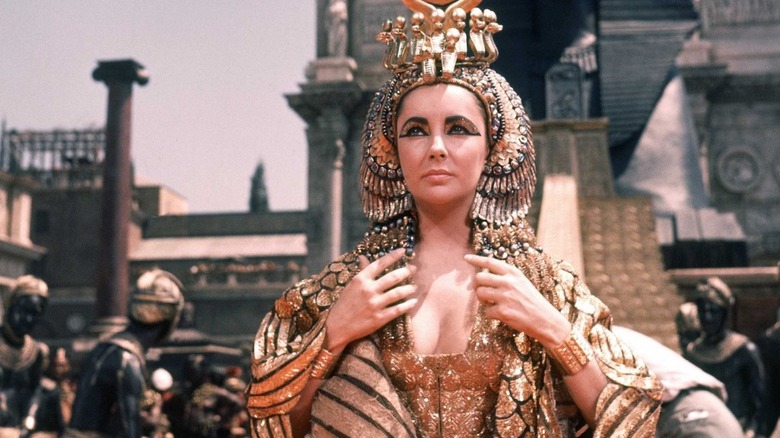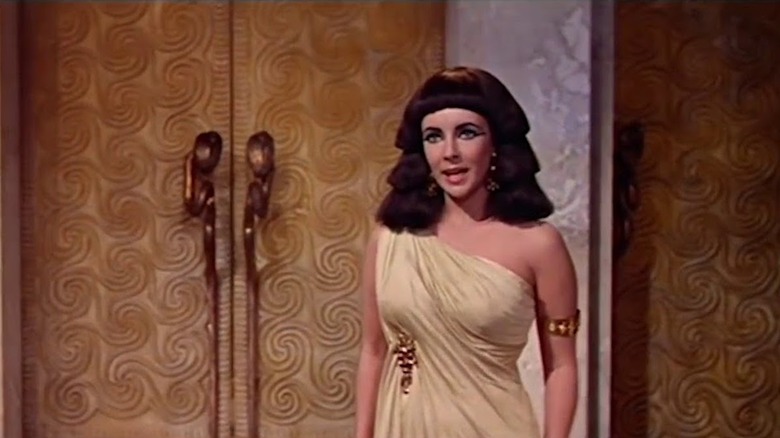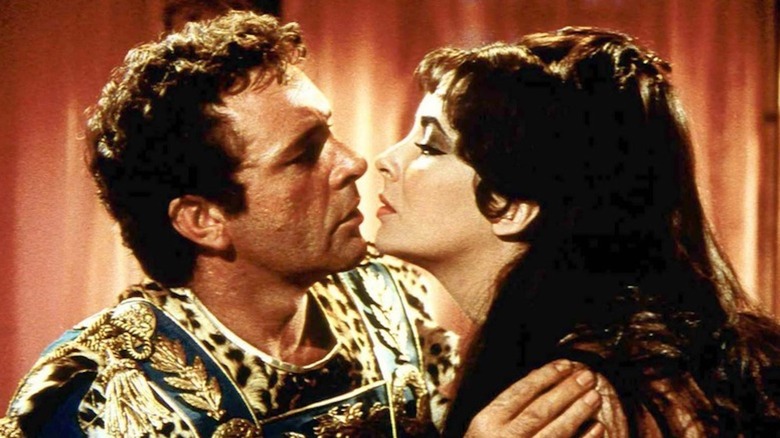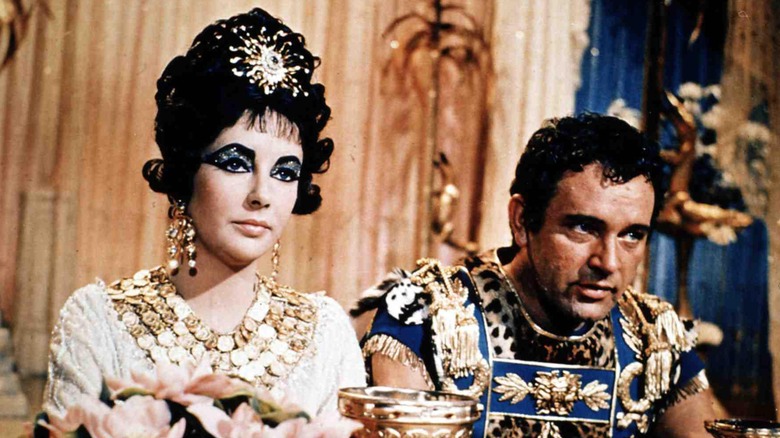Did Elizabeth Taylor's Cleopatra Casting Almost Bankrupt Fox?
20th Century Fox couldn't have picked a worse time to mount its epic production of "Cleopatra." The studio was reeling after a string of box office disasters in 1958 (most notably "The Barbarian and the Geisha," "A Certain Smile" and "The Roots of Heaven"), which prompted its president, Spyros Skouras, to do the wholly unreasonable thing and pin the company's financial recovery on one historically massive production. On executive David Brown's advice, Skouras reached back 40 years into the studio's past, and threw everything into a new rendition of "Cleopatra." The sweeping tale of the ill-fated Queen of Egypt had delivered in a big way for Fox before. Why couldn't it do so again?
Though "Cleopatra" would eventually go on to turn a modest profit at the conclusion of its 1963 theatrical run, the damage to the already struggling studio had already been done. Budget overruns due in part to turmoil on the set of the epic had forced the studio to sell off a huge chunk of its backlot (which would eventually be turned into Century City). Belt-tightening was in order, but "Cleopatra" was way too far down the track for Fox to cancel it altogether. While Fox scrambled to stop the bleeding, its keister-covering top brass used the press to place the blame squarely on the film's star, Elizabeth Taylor. Was this fair?
Prelude to a calamity
When principal photography for "Cleopatra" commenced on September 28, 1960, Taylor created an immediate conflict by bringing her American hairdresser to London's Pinewood studios, which infuriated the country's hairstylists' union. There were intermittent delays as Taylor struggled through a cold, which eventually turned into meningitis. The ensuing pause in production allowed producer Walter Wanger to hire Nunnally Johnson to rework the first half of the script. When director Rouben Mamoulian objected to Johnson's draft, Fox, already furious that a mere 10 minutes of usable footage had been shot over 16 weeks, fired the filmmaker and, after consulting with Taylor, hired Joseph L. Mankiewicz.
Mankiewicz also hated Johnson's work, so the studio brought on novelist Laurence Durrell and Oscar-winning screenwriter Sidney Buchman to collaborate with the director (who'd previously won two screenwriting Oscars himself). The script would never be entirely fixed, though you wonder if the production might've gotten back on track had Fox acceded to Mankiewicz's demand to write the whole damn thing himself as a two-part epic (with each version running in the neighborhood of three hours). There was no such thing as a television miniseries in the early 1960s, but, in terms of the story's breadth, that's essentially what Mankiewicz was proposing. Fox, of course, shot this down, and forced him to power through the shoot. They desperately needed to stop throwing money at this production and get it into theaters ASAP.
The scandal of 1962
Mankiewicz was essentially starting from scratch when principal photography resumed on September 25, 1961. He was working around the clock, directing during the day and taking amphetamine injections so that he could lay down more track via the screenplay at night (the film was supposed to be shot in sequence). Bringing "Cleopatra" would be a slog, but at least he had a clear destination. Alas, he couldn't anticipate that his two stars would create the scandal of the year on the way there.
The affair hardly came out of nowhere. Taylor had been taken with Richard Burton since catching him on Broadway as King Arthur in "Camelot." The studio considered numerous actors for the role of Marc Antony, but Taylor only had eyes for Burton, so the studio bought out his "Camelot" contract and Taylor got her man.
Their on-set romance caught fire in early 1962, and the resulting conflagration burned up the scandal sheets. With gossips hypocritically chiding the lovers for betraying their respective spouses, "Cleopatra" had become a full-blown migraine for the studio — which wound up being a perverse blessing in disguise. Beleaguered executives could now deflect outrage from irate shareholders by scapegoating Taylor and Burton. Taylor was already an easy target given that her illness had forced a close-to-year-long interruption in shooting, so Fox happily promoted the narrative that Taylor was an out-of-control diva threatening to bankrupt a major studio. They singled out her $50,000 a week salary, and demanded that Mankiewicz wrap her by June 1962. Mankiewicz actually hit this deadline, but Taylor, fearful that her presumed absence from the set would provide Burton's jilted wife, Sybil, the opportunity to fly to the Rome set for an attempted reconciliation, forbade the studio from announcing that she had completed work on the movie.
Love means never having to cough up $50 million to Fox
"Cleopatra" earned just enough critical goodwill for Fox to credibly push it as an Oscar contender. The film earned nine nominations (including one for Best Picture), and won four below-the-line trophies. Taylor, who was badly miscast in the first place (Mamoulian initially wanted African-American star Dorothy Dandridge for the lead, and she would've been perfect), absorbed the brunt of the critical opprobrium. Worse, she was subsequently slapped with a nuisance lawsuit by Fox, which sought redress in the amount of $50 million from her and Burton for having the temerity to fall in love during the shoot (the lawsuit went nowhere).
Taylor wasn't entirely blameless for the production's difficulties, but the notion that her spoiled-brat behavior single-handedly undermined "Cleopatra" is total bunk. Skouras was the genius who tried to save the studio by throwing a ludicrous amount of cash — $31 million then, $300 million now — at one movie, and stood by as the project drifted aimlessly into production without anything close to a finished screenplay. So the next time you have the pleasure of visiting the concrete paradise of Century City, think of "Cleopatra," sure, but spare a thought for Spyros Skouras and more than a little sympathy for Elizabeth Taylor.



